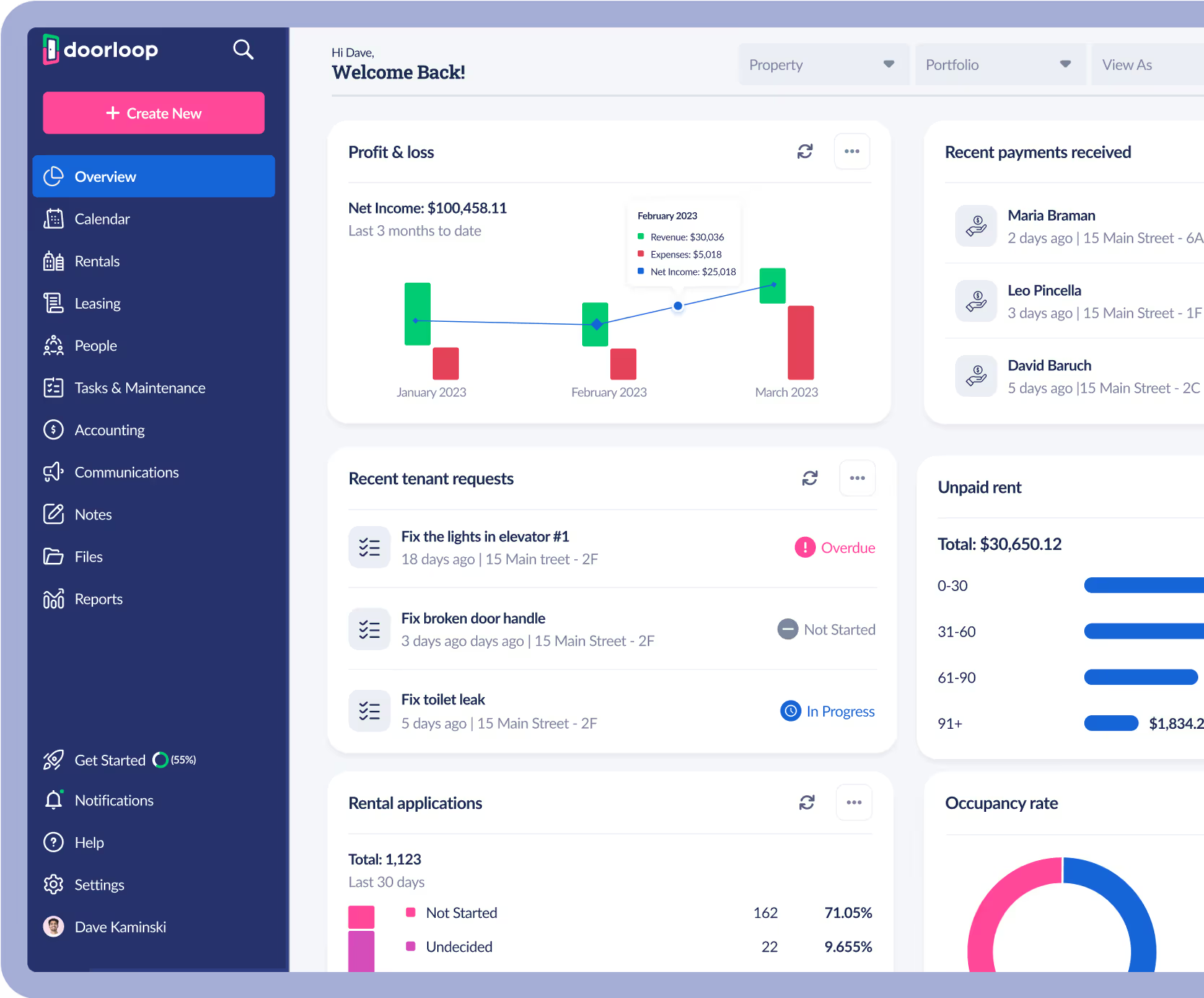A room rental agreement is a legally binding contract between a tenant and the person they intend to rent a room to as a subtenant.
The original tenant and the sublessee's expectations and duties are spelled out in detail in this document. This agreement is effective upon execution and is binding upon the parties specified.
If you're looking for a room rental agreement sample, DoorLoop offers a variety of real estate rental forms for you to choose from.
Download a free room rental agreement template
Ready to get started? Download our free template right now, available in both PDF and Word formats. It’s designed to be simple, fast, and easy to customize for your exact needs.
What to include (quick checklist)
When creating this kind of document, there is no restriction on how specific you can be. However, a simple room rental agreement ought to have the following fundamental components:
- Property address
- The subtenant's and principal tenant's contact information
- House rules
- Rent amount and due date
- Room description
- Utility costs
- Late fees
- Lease term
- List of household chores
- Move-in requirements
- List of furniture and other additional things provided, such as parking space
- Notice of period to terminate the rental agreement
- Signatures and date
- Subtenant's renters insurance
Don't forget to include the revenue from room subleasing on your tax return. Refer to our rental income tax calculator to calculate your potential tax liability.
Any repairs you need to make to the room and communal areas mentioned in the agreement will be deductible.
What is a rental room agreement?
A room rental agreement is a simple contract between the original tenant and a new tenant renting a single room. Think of it as the official rulebook for your shared space. 🤝
You'll want to use one anytime you're subletting a room in your apartment or house. It’s perfect for setting clear expectations on rent, rules, and responsibilities to avoid future headaches.
When you need the landlord’s permission
Real estate rule number one: Always check your original lease first! 🚨
Most lease agreements have a subletting clause. This section will inform you about the rules for renting out a room and outline the process. You almost always need to get written permission from your landlord before anyone else moves in.
Skipping this step could put you in violation of your lease, which can lead to serious problems, including eviction.
Room rental vs. roommate agreement
Getting these two mixed up is super common, but they do completely different jobs. The main distinction boils down to one key question: Is the landlord involved?
- A Room Rental Agreement (often called a Sublease) is a formal contract where an existing tenant rents out a room to a new person (the subtenant). It involves the landlord.
- A Roommate Agreement is a contract between tenants living in the same property. It's all about house rules, chores, and shared costs, and it doesn't involve the landlord.
The biggest differences come down to who needs to give permission and who's on the hook if things go wrong.
Key differences in consent and liability
Room Rental Agreement / Sublease:
- Consent: You must get the landlord's consent. Your original lease almost certainly requires it.
- Liability: The original tenant is still 100% responsible for the full rent and any damages. You're essentially the new tenant's landlord, which is a big deal. 😬
Roommate Agreement:
- Consent: No landlord consent needed. This is a private agreement just between the roommates.
- Liability: This agreement doesn't change the lease. If one roommate flakes on rent, the landlord will still expect the full amount from the tenants whose names are on the actual lease.
How to fill out a rental room agreement
Our template is designed to be super simple. Here’s a quick look at the key sections you'll need to fill out to make it official.
1. The Basics (Who, Where, When)
This section identifies the people, the place, and the timeline.
- Names: Write the full names of the original tenant and the new tenant.
- Effective Date: List the agreement’s actual start date.
- Property Address: Include the full street address, plus any unit, apartment, or specific room number.
- Lease Term: State the start and end dates. If it's not a fixed term, specify that it's a month-to-month agreement.
2. The Money (Rent, Deposit, Utilities)
Be crystal clear about every dollar.
- Rent & Deposit: State the exact monthly rent amount and the total security deposit. Get your security deposit receipt template here.
- Payments: Define the rent due date, any grace period, and the specific late fee (e.g., "$50 if more than 5 days late").
- Utilities: List which utilities are included in the rent and which are not. For shared bills, specify how they will be split (e.g., 50/50, by person) and whose name is on each account.
3. The Perks (Parking & Amenities)
If there are extra benefits, define them here.
- Parking: State clearly whether parking is included. If it is, describe the location of the spot and include the new tenant's car details (make, model, license plate).
- Pet-friendly: Cover the prie of a pet deposit and any specific requirements like maximum size, weight, etc.
4. The Rules (Behavior, Guests, & Chores)
This is the most important section for keeping the peace. Get specific on your house rules.
- Guests & Parties: Define the policy for overnight guests (e.g., "max 3 nights per month with 24-hour notice") and any rules for parties or large gatherings.
- Quiet Hours: Set specific times (e.g., 10 PM - 7 AM) to ensure noise levels are low and everyone gets a quiet space.
- Lifestyle Rules: Outline rules on pets, smoking, and alcohol use. Be specific about designated smoking areas if you allow it.
- Chores: List any shared household duties and the expectations for keeping common areas clean.
Step 5: The Fine Print (Legal Clauses)
Cover the official terms to protect everyone involved.
- Early Termination: State the exact notice period required if the tenant wants to move out early (e.g., "30 days' written notice").
- Renter's Insurance: Specify whether the new tenant is required to have renter's insurance.
- Governing Law: Mention that the agreement is subject to the laws of your state.
⚠️ A Quick Note on Fair Housing Laws
When you're advertising for and choosing a roommate, Fair Housing Laws apply, but with a key exception.
- The Main Rule: You cannot discriminate in your ad or choice based on race, religion, nationality, disability, or family status.
- The Big Exception: You can legally state a preference for a specific gender when advertising for a roommate who will be sharing your living space (e.g., "Female seeking female roommate").
Housing rules to prevent disputes
A written agreement is your best tool for tackling common roommate problems before they start. Here are a few key areas to cover:
- The Constant Guest. 🧑🤝🧑 Set clear rules for overnight visitors and parties to make sure your home stays a quiet, private space when you need it to be.
- The Un-shoveled Driveway. 🧹 Define who handles bigger property maintenance tasks like lawn care or snow removal. Putting it in writing ensures the work is shared fairly.
- The Never-Ending Pile of Dishes. 🍽️ Spell out how you'll divide daily chores and the cost of shared supplies (like cleaning products or paper towels). This prevents one person from feeling like they're doing—and paying for—everything.
Potential consequences of renting out a room
You open yourself up to many risks, additional costs, and possible legal action if you fail to draw up and sign a sublease agreement.
By creating an agreement when renting out a room, you can avoid some of the following unnecessary hardships:
- Lost time: If a roommate leaves early and without notice, you may be forced to impulsively start looking for a new subtenant. Therefore, if you end up with a difficult roommate because you were in a rush, you might have to deal with several problems or clean up your roommate's messes. You could also miss out on valuable sleeping hours if they constantly have guests over or throw parties.
- Lost money: If a sublessee vacates the premises early without giving warning, the other party will have to pay higher rent, lose the security deposit, or foot the bill for any property damage.
- Stress and anxiety: Any relationship will face strain when tenants' rights and responsibilities aren’t laid out clearly. A sublessee's actions or failure to pay rent on time, might result in your landlord being suspicious of you. Furthermore, if your housemate is your friend, your relationship might suffer because of minor misunderstandings.
- Lost property: If you don’t have one of these agreements, the other tenant could steal or damage any of your personal items. Moreover, one person could be burdened for paying any damages to shared property that occur during the tenancy.
Taxes: Reporting sublease income and expenses
If you have a U.S. tax obligation, don't forget that the rent money you collect is usually considered taxable income. The good news is that you can also deduct a portion of your expenses—such as the percentage of your own rent and utilities that apply to the rented space.
It's wise to maintain accurate records of all payments and expenses. For the official rules on what you can report and deduct, the IRS Publication 527 (Residential Rental Property) is your best resource.
DoorLoop Forms
While renting out a room might seem simple, it can get complicated at times, which is why it's crucial to have a written room rental agreement in place.
From the amount of rent and security deposit to house rules, parking, chores, and more, this agreement discusses everything you need to have a comprehensive sublease in place.
If you're looking for a free and comprehensive room rental agreement form or any other type of residential lease agreement, make sure to check out DoorLoop.
We have an endless supply of free forms and templates to ensure that you manage your properties and room rentals effectively and efficiently.
Rental room agreement FAQ
What happens if a roommate breaks the rental agreement?
You can't just kick them out or change the locks. Eviction is a formal legal process.
- A Court Order is Required: Only a law enforcement officer (like a sheriff or marshal) can legally remove someone from a property, and only with an official court order. "Self-help" evictions are illegal in most places.
- Give Written Notice: The first step is always to provide a formal written notice that states the violation, as required by your state's law and the terms of your lease.
- File an Eviction Case: If the roommate doesn't fix the issue (or move out), the landlord (or you, as the master tenant, if legally permitted) must file an eviction lawsuit to get that court order.
📚 Read: Free Eviction Notice Form for Landlords (Print, Word & PDF)
What happens if a roommate abandons the lease?
This depends entirely on their legal status on the lease.
- If they're on the main lease: They are still legally responsible for their share of the rent until the lease term ends or the landlord or property manager agrees to release them. To recover what they owe, you may be able to sue them in small claims court.
- If it's a month-to-month lease: They can't just vanish. They must provide proper written notice as defined by state law. For example, both Texas and New York (outside NYC) generally require about one month's notice. Leaving without notice could mean they're liable for the next month's rent, depending on the state’s landlord-tenant laws.
Should a roommate be added to the original lease agreement?
Yes, absolutely. Just make sure you're thorough.
- List everyone by name. Every single subtenant's full legal name and contact info must be on the document.
- Define each person's share. Clearly state how much rent and which utilities each individual is responsible for.
- Consider a "joint and several liability" clause. This is a technical but powerful term. It means that if one subtenant fails to pay their share, the others are still legally responsible for the entire rent amount. (Check if this is permitted in your state).
Does a room rental agreement cover more than one tenant?
Yes, a sublease agreement may cover more than one tenant. However, you need to list the names and personal information of each tenant in the rental contract.
Tenants may be expected to pay a variety of utility costs based on the size and amenities of the room. Make sure to mention this in the contract as well.































.avif)
.svg)
.svg)

